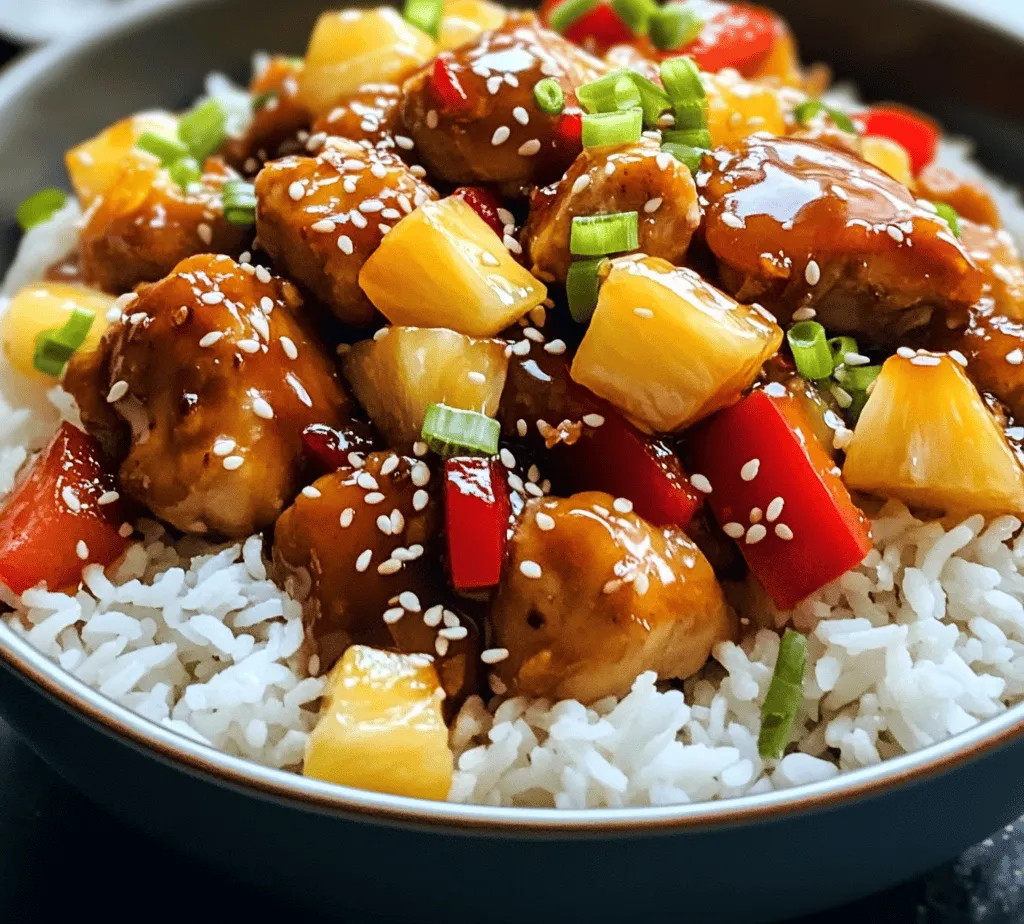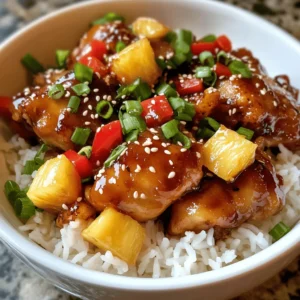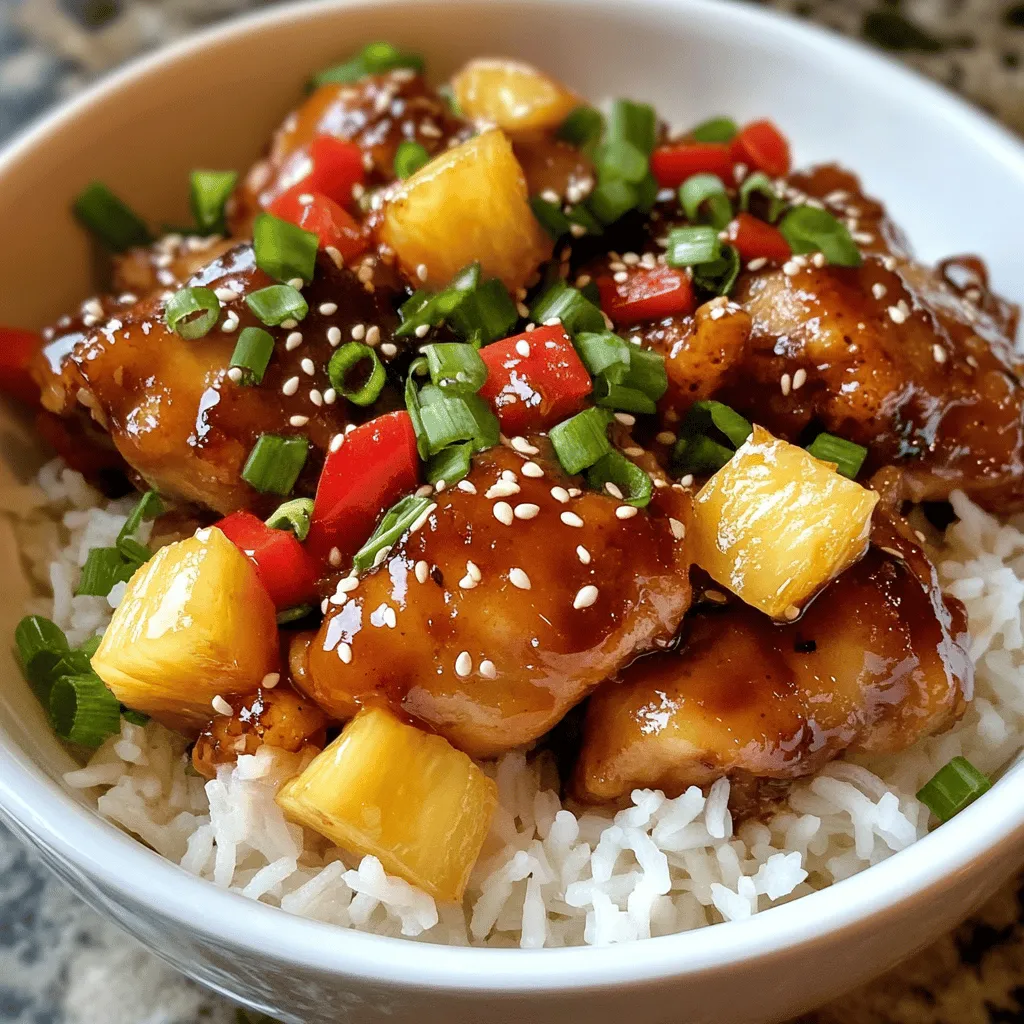Introduction
Sweet and Savory Pineapple Chicken is a delightful dish that perfectly marries the tropical sweetness of pineapple with the savory depth of succulent chicken. This dish has gained popularity not only for its vibrant flavors but also for its ability to transport your taste buds to a sunny beach paradise with every bite. The balance of sweet and savory elements creates a harmonious flavor profile that appeals to a wide range of palates, making it a favorite among families and food enthusiasts alike.
Pineapple chicken is incredibly versatile; it can be served at family dinners, casual gatherings, or even special occasions. Whether you’re looking for a quick weeknight meal or an impressive dish to wow your guests, this recipe fits the bill. It pairs beautifully with a variety of sides, from fluffy rice to fresh salads, allowing you to customize your meal to suit any occasion.
Understanding the Ingredients
To create the perfect Sweet and Savory Pineapple Chicken, understanding the ingredients is essential. Each component plays a vital role in crafting the dish’s unique flavor and texture.
Key Ingredients and Their Roles
1. Chicken Thighs: The star of this recipe, chicken thighs are known for their rich flavor and juicy tenderness. Compared to chicken breasts, thighs contain more fat, which helps prevent dryness during cooking, making them a fantastic choice for this dish. The additional fat contributes to the overall savoriness of the meal.
2. Pineapple: Whether you choose fresh or canned, pineapple is the key ingredient that adds a burst of sweetness and acidity to the dish. Fresh pineapple is ideal for its bright, juicy flavor and natural enzymes that help tenderize the chicken. If opting for canned pineapple, choose unsweetened varieties to control the sugar content.
3. Soy Sauce: This umami-rich ingredient adds saltiness and depth to the marinade. It enhances the savory notes of the chicken and complements the sweetness of the pineapple beautifully.
4. Brown Sugar: Used in the marinade, brown sugar contributes to the caramelization of the chicken during cooking, resulting in a delightful glaze that coats the chicken and pineapple.
5. Garlic and Ginger: Fresh garlic and ginger bring aromatic flavors to the dish. Their pungency balances the sweetness of the pineapple and adds complexity to the overall profile.
6. Rice: Serving the pineapple chicken over rice provides a neutral base that absorbs the delicious sauce. Jasmine rice is particularly favored for its fragrant aroma and slightly sticky texture, which works well with the dish’s sweet and savory profile.
Health Benefits of Chicken Thighs
Chicken thighs not only enhance the flavor of your dish but also pack a nutritional punch. They are an excellent source of protein, essential for muscle growth and repair. Additionally, chicken thighs contain vitamins B6 and B12, which support energy metabolism and neurological function. Their higher fat content compared to chicken breasts provides a source of healthy fats, contributing to overall satiety and flavor in your meals.
Nutritional Benefits of Pineapple
Pineapple is more than just a sweet addition to your chicken dish; it also offers a range of health benefits. Packed with vitamin C, pineapple supports a healthy immune system and promotes collagen production for healthy skin. It also contains bromelain, an enzyme that aids in digestion and may help reduce inflammation. The natural sugars in pineapple provide a quick energy boost, making it an excellent ingredient for active lifestyles.
Fresh vs. Canned Ingredients
Using fresh ingredients can significantly elevate the flavor and nutritional value of your dish. Fresh pineapple, for instance, offers a superior texture and taste compared to canned pineapple. However, canned pineapple can be a convenient and time-saving option. When using canned pineapple, look for varieties packed in juice rather than syrup to keep added sugars to a minimum. Ultimately, the choice between fresh and canned comes down to personal preference and availability.
Preparation Steps
Marinating the Chicken
Marinating the chicken is a crucial step that enhances the flavor and tenderness of the meat. The marinade, a combination of soy sauce, brown sugar, garlic, ginger, and pineapple juice, infuses the chicken with a depth of flavor that is key to this recipe.
1. Prepare the Marinade: In a mixing bowl, combine 1/4 cup of soy sauce, 1/4 cup of brown sugar, 2 cloves of minced garlic, 1 tablespoon of grated ginger, and the juice of one pineapple (or 1/2 cup if using canned). Mix until the sugar is dissolved.
2. Marinate the Chicken: Place the chicken thighs in a resealable plastic bag or shallow dish and pour the marinade over them. Ensure that the chicken is well-coated. Seal the bag or cover the dish and refrigerate for at least 30 minutes, but ideally for 2 hours or overnight. This marination time allows the flavors to penetrate the meat, making it flavorful and juicy.
Importance of Marination for Flavor Enhancement
The marination process is essential for several reasons. First, it enhances the flavor of the chicken, allowing the savory and sweet elements to seep into the meat. Second, the acidity from the pineapple juice helps tenderize the chicken, breaking down proteins and resulting in a more succulent final dish. Lastly, marinating adds a layer of complexity, with the garlic and ginger providing aromatic notes that elevate the overall experience.
Cooking the Rice
While the chicken is marinating, it’s the perfect time to prepare the rice. Cooking jasmine rice to fluffy perfection is straightforward, and using chicken broth instead of water adds an extra dimension of flavor.
1. Measure the Rice: For every cup of jasmine rice, use 1 1/2 cups of chicken broth. This ratio ensures that the rice cooks evenly and absorbs the broth’s savory notes.
2. Rinse the Rice: Rinse the jasmine rice under cold water in a fine-mesh strainer until the water runs clear. This step removes excess starch, preventing the rice from becoming gummy.
3. Cook the Rice: In a medium saucepan, bring the chicken broth to a boil. Add the rinsed rice, stir once, and then cover with a tight-fitting lid. Reduce the heat to low and let it simmer for about 15-18 minutes, or until the rice has absorbed all the liquid. Once done, remove from heat and let it sit covered for an additional 5 minutes. Fluff the rice with a fork before serving.
Benefits of Using Chicken Broth Instead of Water
Using chicken broth instead of water to cook the rice infuses it with rich flavor, complementing the savory components of the pineapple chicken. The broth adds depth and enhances the overall taste of the dish, ensuring that every element on your plate works together in harmony.
Sautéing the Chicken
Once marinated, it’s time to sauté the chicken thighs to achieve that perfect sear. Properly searing the chicken creates a beautiful caramelization on the outside while ensuring the inside remains tender and juicy.
1. Heat the Pan: In a large skillet or frying pan, heat 1-2 tablespoons of oil over medium-high heat. Ensure the pan is hot before adding the chicken to achieve a nice sear.
2. Cook the Chicken: Remove the chicken thighs from the marinade, letting any excess marinade drip off. Place the thighs in the hot pan, being careful not to overcrowd the pan (you may need to cook in batches). Sear the chicken for about 5-7 minutes on each side, or until golden brown and cooked through. Use a meat thermometer to check that the internal temperature reaches 165°F (75°C).
3. Add Pineapple: After flipping the chicken for the last time, add the pineapple chunks (fresh or canned) to the pan. Sauté for an additional 2-3 minutes until the pineapple is heated through and caramelized. The sugars in the pineapple will enhance the glaze on the chicken, creating a sticky, flavorful coating.
4. Combine and Serve: Once the chicken is cooked and the pineapple is caramelized, combine everything in the pan to coat the chicken evenly in the sauce. Serve the pineapple chicken over the prepared jasmine rice, garnished with fresh cilantro or green onions if desired.
By following these steps, you will create a delicious Sweet and Savory Pineapple Chicken that is sure to impress family and friends. The combination of tender chicken, sweet pineapple, and fragrant rice makes for a satisfying dish that is perfect for any occasion. Stay tuned for the next part of this article, where we will explore tips for achieving the best results and answer common questions about this delightful recipe.

Tips for Checking Doneness and Avoiding Dryness
When cooking chicken, ensuring it is cooked through while remaining juicy is essential for a delightful dining experience. Here are some effective tips for checking doneness and preventing dryness in your Sweet and Savory Pineapple Chicken:
1. Use a Meat Thermometer: The most reliable way to check if your chicken is cooked is to use a meat thermometer. Insert it into the thickest part of the chicken without touching the bone. The internal temperature should reach 165°F (75°C) to ensure it’s safe to eat.
2. Cut and Check: If you don’t have a thermometer, you can cut into the thickest part of the chicken. The meat should be opaque and the juices should run clear, not pink.
3. Marination Time: Be cautious with marinating time; while marinating adds flavor and moisture, over-marinating can lead to a mushy texture. Aim for 30 minutes to 2 hours for the best results.
4. Cooking Time: Avoid cooking on excessively high heat, which can cause the outside of the chicken to char while the inside remains undercooked. A medium heat allows for even cooking.
5. Resting Time: After cooking, let the chicken rest for about 5-10 minutes before slicing. Resting allows the juices to redistribute throughout the meat, ensuring maximum juiciness.
Creating the Sauce
One of the highlights of Sweet and Savory Pineapple Chicken is the delicious sauce that ties the dish together. Here’s how to create the sauce using the marinade and additional ingredients:
Utilizing the Marinade
After marinating the chicken, reserve the leftover marinade for your sauce. This not only adds flavor but also eliminates waste. To ensure food safety, boil the marinade in a saucepan for at least 5 minutes to kill any bacteria from the raw chicken.
The Role of Red Bell Pepper and Pineapple
Incorporating chopped red bell peppers and pineapple chunks into the sauce enhances its sweetness and adds texture. Red bell peppers provide a vibrant color and a sweet crunch that balances the tanginess of the pineapple. Their natural sugars caramelize slightly when cooked, contributing to a deeper flavor profile.
Techniques for Thickening the Sauce
To achieve the right consistency for your sauce, consider the following techniques:
– Cornstarch Slurry: Combine equal parts cornstarch and cold water to create a slurry. Gradually whisk it into your boiling sauce until it thickens to your liking. Allow it to simmer for a few minutes to fully activate the cornstarch.
– Reduction Method: Simmer the sauce over low heat to reduce it. This method intensifies the flavors and naturally thickens the sauce. Stir occasionally to prevent burning.
– Adding Pureed Pineapple: Blend a portion of the pineapple chunks from the marinade until smooth, then stir this puree into the sauce. It not only thickens the sauce but also reinforces the pineapple flavor.
Combining the Ingredients
Once your sauce is ready, it’s time to combine it with the chicken.
Best Practices for Incorporating Chicken into the Sauce
1. Sear First: Sear the marinated chicken in a hot pan until golden brown on both sides before adding the sauce. This step locks in flavor and moisture.
2. Simmer Together: After adding the sauce to the chicken, let everything simmer together for 10-15 minutes. This allows the chicken to absorb the flavors of the sauce, enhancing the overall taste.
3. Stir Gently: When combining the chicken with the sauce, use a spatula to stir gently. This prevents the chicken from breaking apart and ensures an even coating of sauce.
Tips for Plating and Presentation
Presentation can elevate your dish significantly. Here are some tips for plating your Sweet and Savory Pineapple Chicken:
– Serve on a Bed of Rice: A fluffy bed of jasmine or coconut rice serves as the perfect base, soaking up the delicious sauce.
– Garnish: Sprinkle chopped green onions or cilantro on top for a pop of color and freshness. Garnishes not only make the dish visually appealing but also add an extra layer of flavor.
– Consider Color: Use colorful side dishes like steamed broccoli, vibrant carrots, or a mixed greens salad to make the plate visually appealing.
Serving Suggestions
Pairing your Sweet and Savory Pineapple Chicken with the right side dishes and beverages can enhance the dining experience.
Ideas for Side Dishes
1. Coconut Rice: The sweetness of coconut rice complements the tropical flavors of the dish. Cook rice in coconut milk for a creamy texture.
2. Grilled Vegetables: Seasonal grilled vegetables, such as zucchini, bell peppers, and asparagus, add a delightful crunch and freshness.
3. Asian Slaw: A refreshing slaw made with cabbage, carrots, and a sesame dressing provides a crisp contrast to the tender chicken.
4. Quinoa Salad: For a healthier option, serve with a quinoa salad mixed with black beans, corn, and a lime vinaigrette.
Variations for Dietary Preferences
For those with dietary restrictions or preferences, here are some alternatives:
– Vegetarian Option: Substitute chicken with firm tofu or tempeh. Marinate and cook them in the same way to absorb the flavors.
– Gluten-Free: Ensure that the soy sauce used in the marinade is gluten-free, or substitute it with tamari sauce.
– Low-Carb: Serve the chicken with cauliflower rice or spiralized vegetables to keep it low-carb while still being satisfying.
Suggested Wine Pairings or Beverages
To complement the flavors of Sweet and Savory Pineapple Chicken, consider the following beverage pairings:
– White Wine: A chilled Sauvignon Blanc enhances the tropical notes in the dish and offers a refreshing contrast to the sweetness.
– Rosé: A dry rosé can balance the savory and sweet elements beautifully, making it a versatile choice.
– Mocktail: For a non-alcoholic option, try a pineapple and coconut mocktail. Mix pineapple juice, coconut water, and a splash of lime for a refreshing drink.
Cultural Significance and Origins
Pineapple chicken has roots in various culinary traditions, particularly in Asian cuisine. The combination of sweet and savory flavors is a hallmark of many dishes from this region.
In Hawaiian cuisine, sweet and tangy pineapple is often paired with meat, showcasing the island’s tropical produce and flavors. Similarly, in Chinese cooking, dishes like sweet and sour chicken highlight the balance of contrasting tastes that make these meals memorable.
Across different cultures, variations of pineapple chicken can be found, such as:
– Hawaiian Chicken: Featuring a tangy glaze made from soy sauce, brown sugar, and pineapple juice.
– Thai Pineapple Fried Rice: A popular dish that incorporates pineapple, chicken, and spices, served in a hollowed-out pineapple.
– Filipino Sweet and Sour Chicken: A variation that includes bell peppers and a tangy sauce, reflecting the influence of both Chinese and native flavors.
Conclusion
Sweet and Savory Pineapple Chicken is a delightful dish that brings together the best of sweet and savory flavors, making it a perfect centerpiece for any meal. With its easy preparation and vibrant taste, it’s an excellent choice for family dinners, special occasions, or even meal prep for busy weekdays.
Encouraging everyone to try making this dish not only allows for a flavorful dining experience but also fosters a sense of community when shared with family and friends. As you enjoy the balance of juicy chicken, tangy pineapple, and rich sauce, consider the cultural inspirations behind it, and let it spark conversations around the dinner table.
Next time you’re looking for a recipe that’s both satisfying and impressive, look no further than this Sweet and Savory Pineapple Chicken. Enjoy the process, share your culinary adventures, and savor every bite of this delightful dish.



